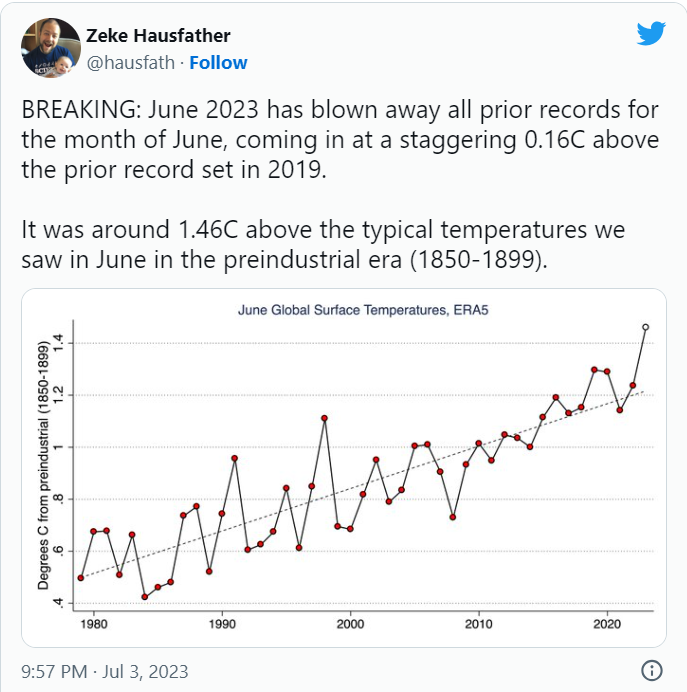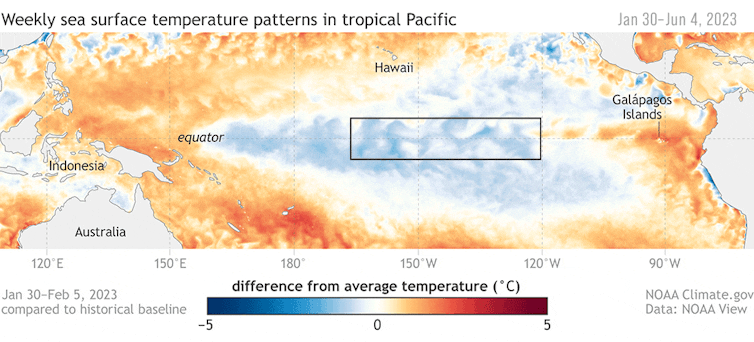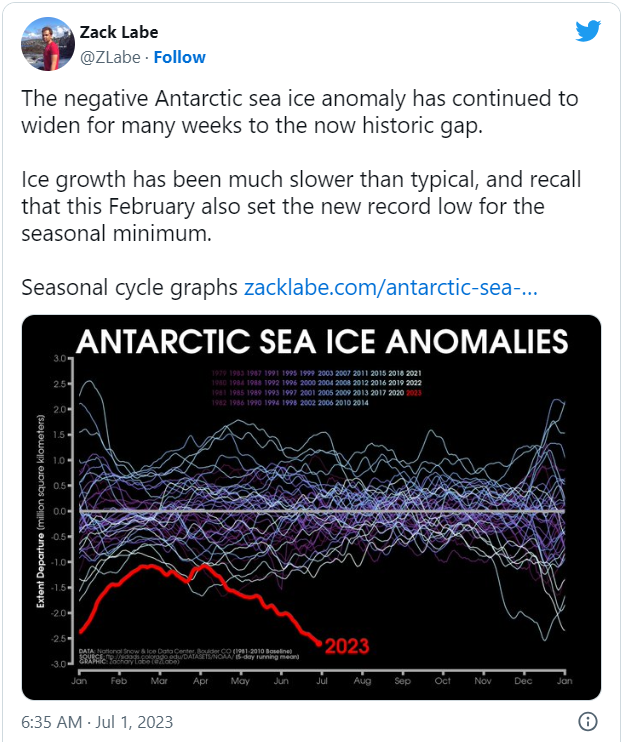Reading Time: 5 minutes
What El Niño means for the world’s perilous climate tipping points
The UN World Meteorological Organisation (WMO) has confirmed it: El Niño conditions have arrived and are expected to become moderate to strong as they develop over the coming year. El Niño is the hot phase of a natural fluctuation in the Earth’s climate system (the full name of which is the El Niño–Southern Oscillation, or ENSO) which normally lasts for a couple of years and is happening on top of a long-term trend of human-driven global warming.
This year is already proving hot. Widespread heatwaves have contributed to the hottest June on record, temperatures in parts of the northeast Atlantic were up to 5°C warmer than normal for June and sea ice around Antarctica is 2.5 million square kilometres smaller than average for the time of year, well below any level recorded since 1979.

This El Niño event is just getting started and so is only partially responsible for these recent extremes. But with global average temperatures already high this year, El Niño strengthening into next year could make 2024 the hottest year on record. El Niño can add up to 0.2°C to global temperatures.
The WMO says it is now very likely that the Earth’s temperature will temporarily exceed 1.5°C above the pre-industrial average by 2027. This is the temperature limit world leaders promised to strive to limit long-term warming to when they signed the Paris Agreement in 2015. Beyond it, scientists predict the impacts of climate change will rapidly escalate.

These impacts could include the triggering of climate tipping points: self-sustaining shifts in the climate system that lock in devastating changes once critical warming levels are passed. An example is the West Antarctic ice sheet, the irreversible collapse of which could be triggered once warming seawater causes it to retreat back in to the deep submarine basin it sits in, eventually adding up to 3 metres to global sea-level rise. Tipping points can also lock in extra global warming by amplifying greenhouse gas emissions from natural sources.

Recent research I led judged that several of these climate tipping points become likely beyond 1.5°C and can’t be ruled out even at current warming of around 1.2°C. So could record global heat turbo-charged by El Niño over the coming years bring these tipping thresholds within reach?
Read more: Climate tipping points could lock in unstoppable changes to the planet – how close are they?
Short-term heat extremes will continue to destabilise systems like coral reefs and the Amazon rainforest which are thought to be vulnerable to tipping. Some smaller ecosystems may tip too, but probably not over the thousands of kilometres necessary to count as a climate tipping point. The retreat of sea ice near the Antarctic peninsula suggests more warmth is reaching parts of the West Antarctic ice sheet too, which could tip even at current warming levels. However, most scientists don’t expect the world to reach a slew of climate tipping points if El Niño causes the world to cross 1.5°C briefly.
The outcome for tipping points
Our estimates for climate tipping point thresholds are based on what would happen if global warming stayed at that level for many years. So a tipping threshold that is estimated to lie at 1.5°C won’t have been reached until global temperatures average 1.5°C for around a decade. Similarly, the Paris Agreement’s lower limit will not be bust upon first contact with 1.5°C – it’s the long-term average rather than a given year (or day) that counts.
The wide ranges over which particular tipping points are estimated to lie mean that we can’t say for sure exactly when tipping becomes inevitable, only that tipping becomes more likely with every fraction of warming within that range. Some systems, like ice sheets, are slow to respond to global warming and may have a window in which conditions can temporarily exceed the critical threshold for a few decades. This offers a chance for warming to be brought below it again before the system is guaranteed to tip over into a new state.
Some commentators worry that recent temperature and sea ice extremes might themselves be the result of tipping points approaching. This is because some complex systems are thought to “flicker” when under stress, briefly jumping to a new state and back again before they permanently tip over. It’s even been suggested that recent extremes might be evidence that tipping is already underway.
Flickering before tipping is possible, but systems like Antarctic sea ice or ocean currents aren’t known to behave this way.

Rather than an unforeseen tipping point approaching, the dramatic extremes in temperature and sea ice extent are best explained as natural variability on top of long-term warming. In other words, they sit within a natural range that is rapidly shifting upwards as a result of global warming. Emissions of sunlight-reflecting aerosols from shipping also fell sharply with new regulations in 2020. These blocked a small amount of warming which is now starting to reappear.
Broken temperature records during an El Niño event are a symptom of underlying global warming, and it’s this long-term warming which will ultimately trigger climate tipping points, especially once the global average passes 1.5°C. An El Niño event will help destabilise some systems, which could tip if they are smaller or respond quickly.
For example, when average warming reaches around 1.5°C, a future strong El Niño temporarily pushing the world’s average temperature to 1.7°C could cause some coral reefs to start dying off before a cooling La Niña arrives. The same could happen during this El Niño if the tipping thresholds for coral reefs happen to lie towards the bottom of their estimated range. However, lower-end climate tipping point thresholds are less likely. For other systems that respond more slowly to warming like ice sheets, the subsequent La Niña should (temporarily) balance things out.
So, it’s unlikely, but not impossible, that this new El Niño event will directly trigger climate tipping points. Instead, coming El Niño events combined with human-driven global warming will continue to break temperature records, and the chance of tipping points being crossed will continue to grow as long-term warming proceeds.
Increasing global warming by continuing to burn fossil fuels will also make future El Niño events more intense. Modelling suggests this may already be happening. Yet more motivation, if it were needed, to cut greenhouse gas emissions as rapidly as possible to limit their damage.
Courtesy – The Conversation








